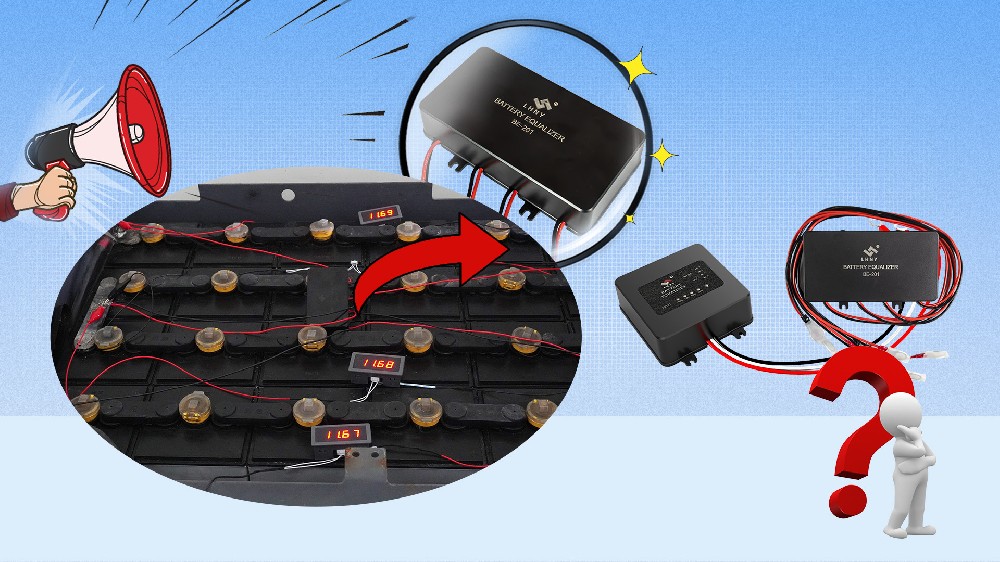In addition to ensuring that the battery pack is not overcharged, the battery management system BMS mainly has the balancing function to maintain the consistency of the battery pack. At present, almost all BMS in the market have the balancing function, which is mainly divided into passive balance and active balance.
What is a battery equalizer?
Battery equalizer, also known as a battery balancer, is an electronic protection device that prevents voltage imbalance among battery cells from reducing the service life of a battery. When the voltage imbalance between battery cells, different cell charging and discharging speed is different. When a cell is charged, other cells are in the state of overcharge or undercharge, and overcharge or undercharge will damage the battery, resulting in reduced battery capacity and shortened battery life. The battery equalizer ensures the power balance among battery cells in real time, extending the battery service life by 5-30%.
There are two main methods of charge balance in a cell: passive balance and active balance.
1. Active balancing (lossless balancing)
Active balancing is carried out in the way of energy transfer, which transfers the high energy of a single cell to the low energy of a single cell, so as to realize the balance of the whole group of voltage. In the process of transfer, almost no energy loss is involved.
Start active balancing conditions: no matter the battery is in charge, discharge, or static state, as long as the pressure difference is greater than the set value will begin to balance, so as long as there is a pressure difference active balancing time should be working 24 hours a day, until the pressure difference is less than the set range to stop.
Active balancing current: Since active balancing is a way of energy transfer without heating, all the balancing current can be larger without affecting heat dissipation. Generally, active balancing current can be 1~2A.
Since active equalization is not limited by the charging time, the equalization time is long, and the equalization current is large, it is suitable for large-capacity battery packs.
2. Passive equilibrium
Passive balancing usually discharges batteries with a high voltage by means of resistance discharge to release electricity in the form of heat to balance the whole group of voltages and obtain more charging time for other batteries.
Start passive balance conditions: passive balance in the battery fast close to full voltage to start discharge balance, so the start of passive balance balance time is relatively short, from the battery is close to full to full cut-off, according to the charger is different on a few hours of balance time.
Passive balancing current: Because passive balancing is resistance energy dissipation balancing, the energy consumed is released in the way of heat, so in the balancing process of BMS will heat, resulting in the balancing current can not be set too large, otherwise it will cause the battery temperature is too high. Generally, the passive equalization current ranges from 35mA to 200mA, and the larger the equalization current, the more serious the heating.
If the equilibrium current is small, then in the case of large capacity battery pack, the battery balance effect is very low efficiency, to achieve balance takes a long time, in the application of a feeling of scratching the surface. Passive equalization circuit is simple, low cost, suitable for low capacity battery packs.
Note: Passively balanced series of batteries can only be used for lead-acid and nickel-based batteries. Active balancing method The balancing method does not depend on the chemical characteristics of the battery and can be used on most types of modern batteries.

Passive equalization principle – The role of battery equalizer
1. Extend the service life
2. Reduce battery replacement
3. Maintain charge balance
4. Save on extras
5. Insulation components
6. Seal design
Common problems of Equalizer: Is the balance switch on or unbalanced?
The trigger differential pressure value set to 4V is incorrect. Change 0.003V or above. Or use the default trigger value 0.01V to restore the balancing function.
Special reminder:
The following conditions must be met to start the equilibrium:
1. The actual number of strings is equal to the set number. No prompt “The number of cells is inconsistent with the set” is displayed.
2. There is no warning indicating that the resistance of the balance line is too large
3. The actual pressure difference should be greater than the “trigger equilibrium pressure difference” in the parameter.
